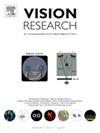Alternating pattern orientation or phase can increase the amplitude of the visual evoked potential
IF 1.4
4区 心理学
Q4 NEUROSCIENCES
引用次数: 0
Abstract
Reversing, achromatic patterns generally produce large and characteristic evoked responses. However, pattern onsets produce large and reliable evoked potentials for chromatic stimuli, while pattern reversal responses are considerably weaker. These differences likely arise in part from the transient and sustained nature of the achromatic and chromatic pathways, respectively; contrast adaption of the sustained, chromatic pathways may also contribute to these observations, as time-averaged contrast is higher for pattern reversals than for pattern onsets. Evidence suggests chromatic pathways may also be tuned for orientation similar to achromatic pathways. Changing orientations may stimulate additional neural populations and reduce contrast adaptation’s effect on the evoked potential. We recorded responses to chromatic and achromatic patterns using both onsets and reversals, with and without alternating orientation. As a control, we included a “reversing” onset condition with a 180-degree spatial shift between presentations. Results revealed that responses binned over 6 s did not exhibit adaptation over 60 s. Chromatic onsets with alternating orientation or phase resulted in larger amplitudes and shorter latencies. Both orientation and phase changes increased chromatic onset responses for the L-M axis, but VEP amplitudes were smaller for alternating phases than for alternating orientations on the S-axis. One possible explanation is that in addition to recruiting different orientation-selective neurons, alternating phase or orientation produces motion responses, which are more prominent in L-M pathways than S pathways. Alternating the phases or orientations of the patterns likely increases the evoked response by recruiting additional neuron populations but at the cost of pathway specificity.
交替的模式取向或相位可以增加视觉诱发电位的振幅
相反,消色差模式通常产生大的和特征性的诱发反应。然而,模式启动对色刺激产生大而可靠的诱发电位,而模式反转反应相对较弱。这些差异可能部分来自消色差和彩色通路的短暂性和持续性;持续的彩色路径的对比度适应也可能有助于这些观察,因为模式反转的时间平均对比度高于模式开始。有证据表明,色觉通路也可以像消色觉通路一样调整方向。改变取向可能刺激额外的神经群,降低对比适应对诱发电位的影响。我们记录了对彩色和消色差模式的反应,使用了开始和逆转,有和没有交替的方向。作为对照,我们纳入了一个“反转”发病条件,在表现之间有180度的空间移动。结果表明,超过6 s的反应不表现出超过60 s的适应性。交替取向或相位的色散发作导致较大的振幅和较短的潜伏期。取向和相位变化均增加了L-M轴上的色度起始响应,但在s轴上,交替相位的VEP振幅小于交替方向的VEP振幅。一种可能的解释是,除了招募不同的定向选择神经元外,交替的相位或定向产生运动反应,这在L-M通路中比S通路更突出。交替模式的阶段或方向可能通过招募额外的神经元群来增加诱发反应,但以途径特异性为代价。
本文章由计算机程序翻译,如有差异,请以英文原文为准。
求助全文
约1分钟内获得全文
求助全文
来源期刊

Vision Research
医学-神经科学
CiteScore
3.70
自引率
16.70%
发文量
111
审稿时长
66 days
期刊介绍:
Vision Research is a journal devoted to the functional aspects of human, vertebrate and invertebrate vision and publishes experimental and observational studies, reviews, and theoretical and computational analyses. Vision Research also publishes clinical studies relevant to normal visual function and basic research relevant to visual dysfunction or its clinical investigation. Functional aspects of vision is interpreted broadly, ranging from molecular and cellular function to perception and behavior. Detailed descriptions are encouraged but enough introductory background should be included for non-specialists. Theoretical and computational papers should give a sense of order to the facts or point to new verifiable observations. Papers dealing with questions in the history of vision science should stress the development of ideas in the field.
 求助内容:
求助内容: 应助结果提醒方式:
应助结果提醒方式:


